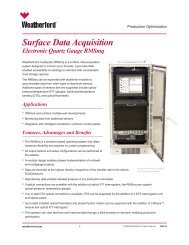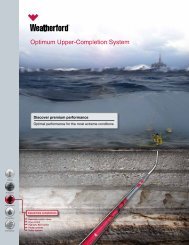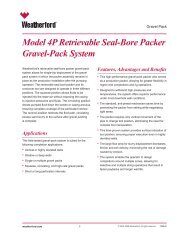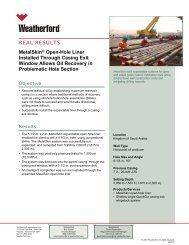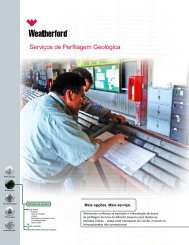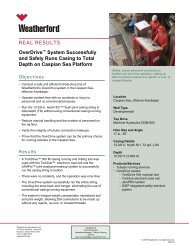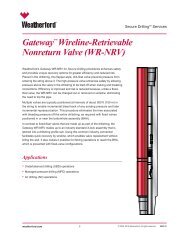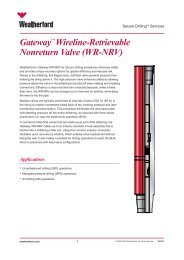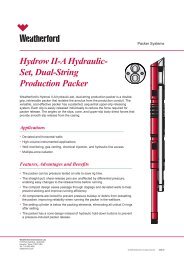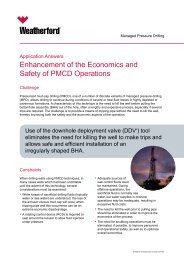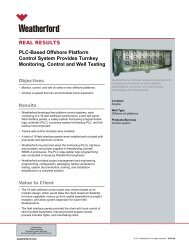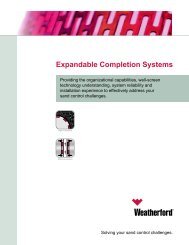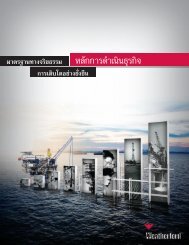Magazine - Weatherford International
Magazine - Weatherford International
Magazine - Weatherford International
- No tags were found...
You also want an ePaper? Increase the reach of your titles
YUMPU automatically turns print PDFs into web optimized ePapers that Google loves.
Deepwater Completion Installation,a Seamless Team EffortCareful planning and execution enabled a team of <strong>Weatherford</strong> and Asia Pacific client engineers to install ESS ®expandable sand screen in a single trip for a Malaysian field development—the first deepwater field offshore Malaysia.Northwest of the Malaysian island of Labuan and ata water depth of 4,331 feet (1,320 meters), existsan impressive development with equally impressivedevelopment challenges. The field—the first deepwaterdiscovery in Malaysia—has a highly laminated reservoirstructure containing many different multilayered sandstoneformations with a wide granular size distribution. Someproducing zones are mere inches thick.“The ESS technology hasyielded skins that areclose to zero or negativein some cases, whichtranslates to greaterproduction and—in wellscontaining a water zonebelow the producinginterval—an offset in thetime to water production.”To produce the440-million-barrelproject during itsexpected 20‐yearlife span, a majorregional operatorrealized thateffective sandcontrol would bea vital componentof its completionstrategy. Notonly would thechosen systemhave to safely andefficiently controlthe unconsolidatedand poorly sorted sands while isolating the shales, itwould also have to achieve this feat on a tight budgetand with a minimum of personnel and equipment.Following an extensive selection and tender process,the operator chose <strong>Weatherford</strong>’s ESS expandablesand screen technology in combination with swellableelastomer packers to control sand production andprovide zonal isolation for the field.“The operator’s analysis showed that their only othersand-control option was a frac pack,” says Brian Scott,<strong>Weatherford</strong>’s Regional Business Unit Manager for SandControl, Malaysia. “Requirements for the frac-pack optioninclude heavy-pumping equipment, mixing and blendingequipment, and crews of 10 or more people. Comparedto an ESS solution, a frac pack would have cost theoperator an additional US$20 million in capital expenses.”“Given the high daily rig rates when we began four yearsago, the client knew the costs to install these wells wasgoing to be huge,” says Kevin McWilliam, <strong>Weatherford</strong>’sCentral Asia Business Unit Manager for Sand Control.“Therefore, a main objective was to ensure operationalexcellence throughout all phases of their drilling andcompletion program.”Seamless Partnership at all StagesTo install successfully the ESS systems in thesechallenging wells, <strong>Weatherford</strong> and the operatorjoined forces, forming a cohesive team of designers,manufacturing and field engineers, and managers atevery stage of the process. “From the moment we wereawarded the work in 2005, we had a project managerpermanently stationed at the operator’s Kuala Lumpuroffice, working on nothing but the design, procedures andinstallation plan of these completions,” says McWilliam.We developed a management plan based on<strong>Weatherford</strong>’s global Operational Process ManagementSystem (OPMS), which Scott describes as the backboneof the operations management. “Our process for thisfield—which consisted of three distinct phases—wouldhave to be more detailed and more exact than theOPMS, so we expanded on it.”Phase 1: Manufacturing“From their office in Kuala Lumpur, the operator wantedoversight of the manufacturing of all components,” saysMcWilliam. “As a result a manufacturing quality plan wascreated from each of the supply plants before buildingany ESS component.”The operator’s dedicated and independent third-partyinspectorate identified steps that were required to beoverseen and approved. The third-party inspectiongroup had full access to <strong>Weatherford</strong>’s manufacturingcenters, which helped ensure that all equipment wasof the highest standard and that any nonconformanceissues were emphasized to the operator.“As with all phases of this development, the combinedproject management team in Kuala Lumpur made themanufacturing decisions,” adds Scott. “If a manufacturingchallenge arose, the manufacturer would immediatelyreport it to us. We would then decide the appropriatecourse of action to rectify the issue. In this way, the teamensured that every piece of equipment came into Malaysiaas designed and fit for purpose, with no surprises.”october 2009 17



